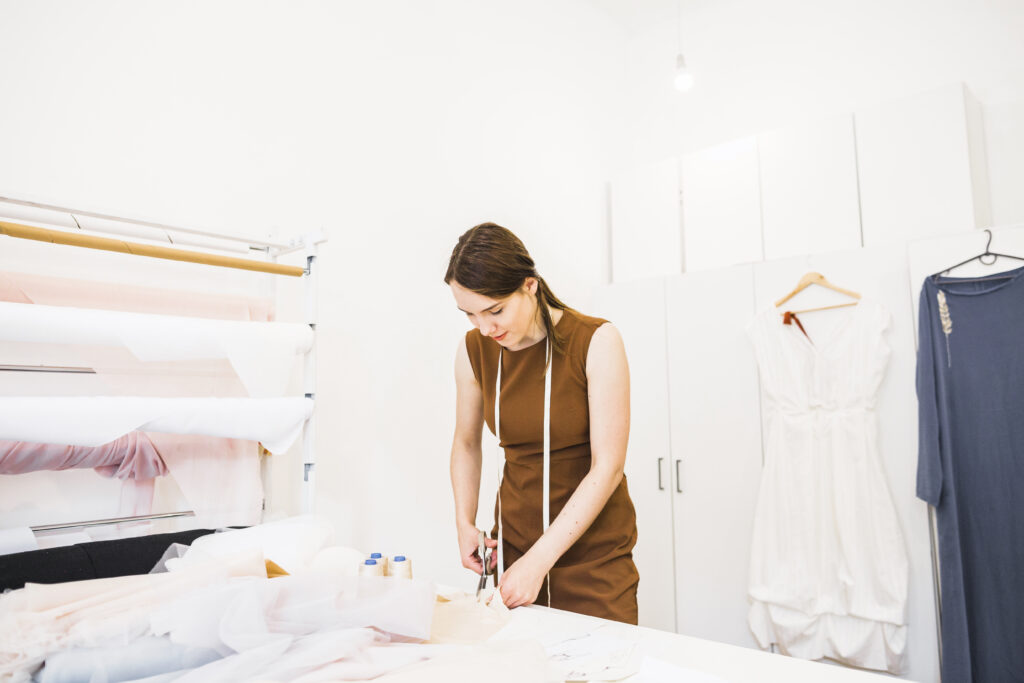Summary:
- Muslin fabric has a lot of history, remarkable versatility, and undeniable charm. However, in today’s industry, many professionals remain unaware of its full potential;
- Whether crafted from silk or cotton, muslin fabric yields garments with exceptional fit, striking contrast, and a luxuriously soft texture;
- Streamline your production process with Audaces360. By using our multi-solution, you can create top-notch samples, reducing raw material waste. Sign up for the free trial now!

Few fabrics offer as much versatility as muslin fabric. Originally from India, it was traditionally made with silk, but nowadays it is predominantly made with cotton.
Muslin fabric is commonly used in ballet uniforms and tutus, but its applications go far beyond that. It is also highly adaptable for creating dresses, skirts, and baby clothes. Fashion professionals who incorporate this fabric into their collections can distinguish themselves in the market.
Every stylist must possess a broad knowledge of different fabrics. The more you know, the greater your creative opportunities become.
For instance, who says muslin fabric can’t be utilized in men’s formal wear? It all depends on the talent and creativity of the professional.
Sumário
It is essential to understand what muslin fabric is, its characteristics, and its various uses.
Enjoy your reading!
What is muslin fabric and what is it used for?
Muslin fabric is renowned for its exceptional versatility. This legendary fabric is famously employed in creating ballet uniforms, commonly referred to as tutus.
But thanks to its adaptability, muslin can be utilized in a wide range of garments, including dresses, skirts, and even baby clothes. It can be combined with tulle, another material commonly used in ballerina tutus. Both fabrics were traditionally associated with bridal gowns but have since found applications beyond the wedding realm.
Certain fashion designers have started incorporating muslin into professional attire, such as office wear while maintaining an elegant and contemporary aesthetic.
However, the decision to do so ultimately depends on the designer’s artistic vision.
Also called mulmul or ‘woven wind’ in India, this lightweight and breathable fabric is commonly used in super stylish saris and even printed tunics, as it’s perfect for the summertime.
Once associated with tulle and bridal gowns, muslin fabric also found its way into shorts, pants, blazers, and tops in fashion collections worldwide.
Learn more: Check out 3 infallible tips to assemble a fashion product mix
What are the characteristics of muslin fabric?

Muslin fabric is known for its thin, transparent, and breathable nature. It is composed of loosely twisted fine threads, which can be made from cotton, silk, viscose, wool, or synthetic materials. This fabric is particularly well-suited for Spring/Summer seasons and designs that feature a crinkled finish.
One of the notable qualities of muslin is its ease of application, and its softness makes it ideal for sensitive skin.
However, it is important to note that pure silk muslin is extremely fragile. It tends to shrink upon contact with water and moisture, which can be problematic considering its higher price range. As a result, muslin fabric has evolved to incorporate more durable materials like cotton.
Across various types of muslin fabric, common characteristics include a textured appearance and a flowing drape. Some variations offer a soft touch and delicate transparency, resembling fabrics like gazar or chiffon, such as the silk touch muslin.
On the other hand, there is heavy muslin, which has a denser weave and a substantial body while retaining its fluidity.
Another type is muslin crepe, which is denser, and more elastic compared to other muslin fabrics but lacks transparency. Nevertheless, it still possesses the characteristic texture and lightweight feel of traditional muslin fabric.
Learn more: 9 fabrics with the perfect fit to use in your fashion collection
How to utilize muslin fabric in your fashion collection?

Muslin fabric offers a myriad of possibilities for creating unique and contrasting garments.
With its delicate drape, it is perfect for crafting elegant dresses, skirts, and blouses with transparent effects.
Additionally, it holds a significant role in the realm of costume-making and dance uniforms.
Moreover, muslin’s softness makes it an ideal choice for designing various baby garments like dungarees, swaddling wraps, overalls, blouses, and pants.
The utilization of muslin is not limited to these options, though. Modern pieces, including blazers, now incorporate this fabric in their designs.
Even applications such as using muslin in men’s clothing, which is not yet commonly seen.
A complimentary fabric that pairs well with muslin in collections is viscose.
The combination of these two fabrics allows for achieving a harmonious balance of lightness, fit, and vibrancy in beautiful garments when the designer understands the nuances. Both fabrics are similarly priced, and they can serve as alternatives to each other based on personal preference.
If you want to obtain the best results, it is recommended to conduct thorough testing and experimentation.
And, to minimize material wastage, also consider the following tips:
Create your designs and optimize fabric usage with Audaces Fashion Studio
Design, test, and recreate your fashion pieces from scratch while minimizing fabric waste with Audaces Fashion Studio.
This comprehensive solution enables you to work with greater precision and efficiency, especially when integrated with other systems and equipment in the Audaces360 multi-solution suite. Discover the advantages of each component within this 360º perfect set:
- Audaces Fashion Studio: A three-dimensional environment that allows you to create sketches and optimize raw materials, ensuring accurate model development;
- Audaces Idea: Automate the creation of technical sheets and pre-costing for your collections. Apply and edit running and localized prints, while utilizing user-friendly and intuitive fashion drawing tools.
- Audaces Isa: Efficiently manage your collections by creating visual collection maps and defining clear steps, enabling streamlined planning and unified goals for the entire team;
- Audaces Digiflash: Digitize multiple pattern sets at once and adapt them seamlessly!
- Audaces Pattern: Create, grade, resize, and modify your patterns directly on the computer, simplifying precise fittings with just a few clicks.
- Audaces Marker and Supera: Automatically generate optimized fabric patterns tailored to your specific needs. This feature is particularly crucial when working with muslin fabric, as it saves time and reduces raw material waste with Supera technology.
- Audaces 3D: Simulate, sew, and approve clothing pieces in 3D. Verify fit and wearability, digitally approve the first sample, and embrace a sustainable and cost-effective process that saves time, money, and raw materials.
Would you like to explore a fabric guide to develop exceptional collections? Then enjoy the free e-book below for your studies and creative endeavors. Download it now:
FAQ
Muslin fabric is a lightweight and sheer type of fabric commonly used in the production of women’s and children’s clothing.
When cutting muslin fabric, it is recommended to include seam allowance and position the pattern correctly on the fabric. Additionally, placing tissue paper underneath the fabric can help stabilize it during the cutting process.
A fabric that pairs well with muslin in collections is viscose. The combination of these fabrics offers a balance of lightness, drape, and vibrancy to the garments.










